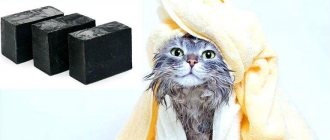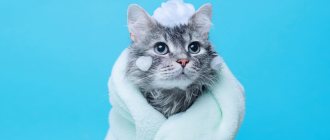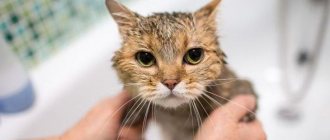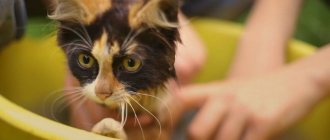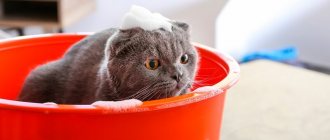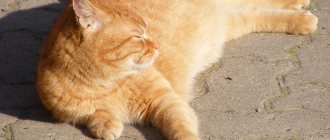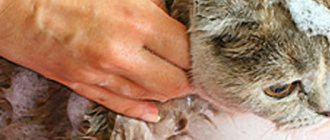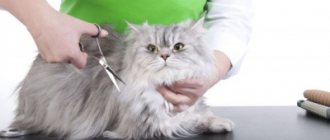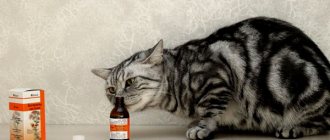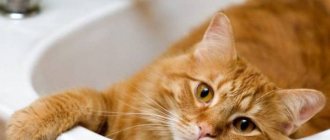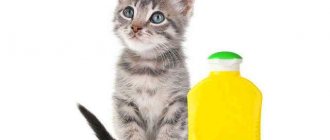Home » Cats » Rules for caring for cats » How to bathe a cat? » Let’s find out whether it’s possible to wash cats with tar soap, laundry soap, baby soap, or regular soap?
Pets need care and attention, so sometimes owners have to force mustaches to undergo water procedures.
Cats are not bathed often . As usual, the need for this manifests itself in cases where the cat, or rather its fur, is heavily soiled or there are other indications, such as the presence of fleas, ticks, and other parasites.
For water procedures, choose specialized weakly alkaline products intended strictly for animals. You can purchase the usual liquid shampoos, gels, shampoo sprays, caring balms and even gentle “cat” soap at veterinary pharmacies.
It is not recommended to bathe animals with human shampoos and ordinary laundry soap . Cat and human skin have different acid-base balance - in cats the pH varies between three and three and a half, and in humans it reaches six.
Therefore, it is not recommended to use non-specialized shampoo for cats. This is fraught with the development of allergies, the appearance of dandruff, dry skin, loss of elasticity and shine of the coat, and its loss. This does not yet take into account individual reactions and possible intolerance.
Is it true that they can’t bathe pets?
Laundry soap should not be used regularly to bathe cats. The detergent contains a high percentage of alkali, which can adversely affect the condition of the skin and coat.
Veterinarians recommend using special medications designed for caring for pets. It is better to select a hygiene product individually, depending on the breed of the pet. Shampoo, soap, shower gel and other formulations intended for humans should also not be used.
Laundry soap can only be used as a last resort, when the cat needs an emergency bath and there is no special product available. However, veterinarians warn that its use may cause an allergic reaction.
Cat owners also confirm the negative effects of laundry soap. According to their reviews, after washing the animal begins to itch, which leads to injury to the epidermis. Your pet may develop dandruff. The cat's fur becomes brittle (breaks) and its shine is lost.
Dust soap
Dust soap is a regular laundry soap that contains dichlorodiphenyltrichloromethylmethane (DDT for short). This is a toxic substance that can penetrate the chitinous cover of insects. DDT accumulates in the body of an arthropod and, at a certain concentration, kills the pest. That is why it is often used to combat lice and fleas.
DDT can kill parasites on the human body
A special feature of DDT is its ability to penetrate through the shell of eggs, not only through the chitinous cover, so the poison accumulates in the body of unhatched “cubs”, thereby destroying the entire population of parasites at once. Thanks to this, dust soap is more effective than many other products.
In addition to this poison, dust soap has a sharp, terrible odor that frightens insects and makes them run away from the source of this “aroma.” Thus, the parasites leave the body of an animal washed with dust soap either alive, frightened by the smell, or dead - straight to the next world.
DDT will kill even a malaria mosquito
DDT perfectly destroys not only lice and fleas, but also other insects. For example, thanks to this substance, it was possible to save about 10 million people in India from a malaria epidemic carried by mosquitoes.
If you need to wash an animal or person at least twice with laundry and tar soap, then one procedure with dust soap is enough. Moreover, doctors strongly discourage frequent use of this product, since DDT accumulates in both the human and animal body, which can lead to intoxication.
Dust soap looks similar to laundry soap
Dust soap is strictly prohibited for use by pregnant women (both women and female animals), since DDT can cause various pathologies in the fetus. Also, it cannot be used for children (in the case of animals - up to one and a half months), since the substance can disrupt the functioning of the nervous system and brain. Children's immune systems are weak and there is a risk of developing cancer.
Benefits of this soap:
- with one-time use it has a calming effect;
- penetrates the chitinous cover and shell of insect eggs, killing them;
Disadvantages of this product:
- high level of toxicity;
- DDT can accumulate in the human and animal body and lead to serious damage to many body systems;
- dangerous for children (both human and animal);
We tried all the remedies in the veterinary pharmacy. Dust soap for 6.50 UAH. the only thing that killed all the fleas))) The packaging says what to do and how to do it. No sprays, drops, or collar helped. No matter what anyone writes about other means. Everything else is a waste of funds! Dot.
nata
https://www.woman.ru/home/animal/thread/4312013/
Does it help against fleas?
Some pet owners try to kill fleas using laundry soap. Even if you soap your cat and then wrap its body in plastic wrap and wait 20-30 minutes, the parasites will not disappear.
The maximum result that can be observed from this method of treating pediculosis is partial washing out of fleas. Insects and nits do not die from laundry soap. Parasites may be repelled by the smell, but this effect does not guarantee that all fleas will leave the pet.
Laundry soap does not have properties that will help get rid of head lice. Therefore, if parasites have been noticed in a cat, you should choose a special remedy.
To treat infestation, you can purchase the following shampoos at a pet store:
- Celandine;
- Biovax;
- Murzik;
- Dude;
- Sweetie;
- Tropiclean Neem Fleas Ticks;
- Sentry PurrScriptions;
- Beaphar Veto Pure.
You can fight fleas in cats using special collars or drops.
Tar soap
Tar soap occupies a special place among cosmetic cleansers. Outwardly, it resembles ordinary laundry soap, but it has a different smell - birch tar, very pungent. Tar makes up approximately 10% of the total composition of the product; everything else is sodium chloride, water, palm oil and fatty acids. They ensure good latherability of the product, and the essential oil softens the effect of alkali.
Tar soap looks similar to laundry soap, but may be a little darker
Tar soap is used mainly to combat small parasitic insects (lice, fleas), which are repelled by its pungent, disgusting smell. But this product has two very useful properties: it heals well and disarms wounds. Parasites feed on the blood of humans and animals, secreting their saliva into our body, which causes an allergic reaction in the form of a burning sensation and rash. For animals, this is unbearable pain; they try to tear the sore spot with their claws, wounds form into which various microbes and bacteria can penetrate, causing inflammation. Tar soap disinfects areas of the skin damaged by pests, reduces pain and itching, and makes it easier for your pet to endure the consequences of the lives of its “inhabitants.”
Tar soap can drive away insects and relieve their bites
Benefits of tar soap:
- environmentally friendly product;
- high alkaline balance;
- has disarming and calming effects;
- low cost;
The disadvantages of this product include:
- contraindication for allergy sufferers: an allergic reaction to tar may occur;
- It is contraindicated for people and animals with thin and dry skin: the skin will become even drier, irritation may occur, even small open cracks;
Tar soap does not kill parasitic insects, it only scares them with its smell, and they escape from the pet’s fur. However, their eggs remain, from which new individuals subsequently hatch, capable of reproduction and parasitism, so you will have to wash your pet with tar soap several times.
Fleas run away from the smell of tar soap, but their eggs remain, so several procedures are needed
Animals have a more delicate sense of smell than people, so the smell of tar soap may be unpleasant to them - you should not leave soap suds on your fur for very long.
Soap dries the skin a little. But only those dogs who have very short and soft hair. For sphinxes or hairless crested animals (CHS) and similar animals, I would not recommend using this soap for bathing. Dries your skin in one go. It dries, not because it’s bad, but because it disinfects and kills germs. Soap acts as an antiseptic and has a positive effect on the skin of animals. But only for dogs and cats! Under no circumstances should you wash rabbits, mice or other animals! Tar soap contains birch tar. No unhealthy fragrances or additives. Clean product! If you are ready to endure the tar smell and are familiar with it, then feel free to buy this soap) It seems to me that it is much more effective than Celandine shampoo. Well, the fact that soap will rid your pet of fleas is a nice addition!
Ksyusha25
https://otzovik.com/review_1135246.html
Application for lichen
In folk medicine, laundry soap is used to treat lichen. The pathological area must be lubricated daily with thick soap suds. This treatment option is used when the lichen is dry. Before the first application, cut off some of the fur around the rash.
The skin disease can be easily treated with medications that can be purchased at the pharmacy. For example:
- Unisan;
- Clotrimazole;
- Thermikon;
- Exoderil;
- Liverazole;
- Terbinafine;
- Imaverol;
- Marfloxin.
To increase the effectiveness of treatment, it is necessary to normalize the pet’s diet and give medications that boost the immune system. For general strengthening of the body, the veterinarian may prescribe Cycloferon or its analogues.
Bathing a mustachioed pet: is it necessary?
It is possible and necessary to bathe a cat, but it should not be done as often as the owners sometimes think. It is recommended to subject a mustachioed family member to water procedures only when necessary. The same applies to hairless cats.
When to bathe:
- when it’s time to tidy up the coat (1-2 times a year);
- presence of external parasites (fleas);
- for therapeutic and prophylactic purposes, using special means;
- in case of heavy pollution, when the pet has free access to the street.
In cats, the skin produces a special secretion that is responsible for local protection of the body (local skin immunity) and for the good condition of the coat (acts as a natural lubricant and care product). With frequent and unreasonable bathing, the secretion is washed off and does not have time to be produced in full, and this already negatively affects both the skin and coat.
Kittens
Using laundry soap to wash fur, kill fleas or treat lichen is unacceptable if the animal is only a few weeks old. Due to the fact that the detergent dries and degreases, irritation will appear on the kitten's delicate skin.
When choosing a shampoo, you should pay attention to the existing regulations. There are products that are specifically designed for caring for small kittens. The instructions additionally indicate the age at which you can start using the detergent.
The same applies to medications whose action is aimed at combating parasites or fungus. If you use a drug intended for an adult animal or do not follow the recommended dosage, your kitten's health may be harmed.
The impact of some substances on a young and fragile body is dangerous - they can cause poisoning. The possibility of death cannot be ruled out.
Precautions when using soap
The most important thing to remember is that soap should not get into your eyes, nose, ears or mouth. It should not be in the ears, because the animal will not allow it to be washed out of there. To prevent foam from getting on the mucous membrane, do not wash your hair - just wash the rest of your body.
Foam from your ears is very difficult to wash out, so try not to get it in there.
You should know about what kind of skin your pet has: you cannot often use laundry and tar soaps if the animal has thin and dry skin - there will be irritation, the skin will become overdried, and may crack.
While laundry and tar soap can be used several times, dust soap should never be used: DDT accumulates well in the body and can even lead to the death of a pet. Therefore, if dust soap does not help get rid of fleas, you need to try another remedy rather than experiment with your animal.
If dust soap does not help, use other means, for example, wormwood essential oil - fleas are afraid of it
Soap can only be used for cats and dogs; Hamsters, mice, rabbits and other pets cannot be washed with soap - it is poison for them. Also, you cannot wash kittens and puppies with soap for up to a month (if we are talking about dust, then up to a month and a half).
What should I wash it with instead?
Some shampoos are preventive, i.e. their action is aimed not only at cleaning the coat, but also at preventing the appearance of fleas or lichen. A veterinarian will help you choose the appropriate composition for caring for an adult or young animal.
We should not forget that some hygienic and antiparasitic substances cannot be used not only by kittens, but also by pregnant and lactating cats.
Not all pets love water treatments. Therefore, while swimming, they need to provide the most comfortable conditions. To wet your cat, you should run water into the bathtub. Recommended temperature is about 37°C. The liquid level should reach half the height of the pet.
If the cat is afraid of a stream of water, then you can wet the fur with wet palms. The next step is soaping. The shampoo is applied in a small amount and gently foamed. Do not allow the product to come into contact with the eyes, mouth and nasal mucosa. Rinse off the shampoo with plenty of water.
After bathing, the animal is wrapped in a dry towel and taken to a warm place. There should be no drafts in the room. You can speed up the drying process by wiping with a dry cloth. If the cat is not afraid of a hair dryer, then it is advisable to use this household appliance.
If your pet still finds it difficult to tolerate water treatments, then preference should be given to dry shampoo. The loose product is distributed over the wool and then rubbed in. It contains absorbent substances that will absorb dirt particles. Complete the cleaning procedure by combing out the shampoo with a brush.
Can I wash my cat with regular soap?
Yes, if you can choose a product with an optimal PH level and track the quality and nature of the other components listed in the composition. It is not recommended to bathe a cat with regular soap or human shampoo for the reasons listed above. Well-groomed hair is important for the cat family, so do not experiment, but use generally accepted and affordable shampoos located on the shelves of any veterinary store.
Why does an animal lick its fur after washing?
Some cats lick laundry or other soap. This behavior can be caused by several reasons:
- I like the smell;
- lack of vitamins and minerals;
- I like the taste (soap contains a lot of fat);
- restores the acid-base balance (intuitively).
Getting any detergent inside can cause poisoning. Therefore, if a cat is licking soap, it is not recommended to ignore its behavior.
When a cat begins to lick itself after bathing with soap, this is a result of the fact that the pet does not feel clean. He begins to tidy up his fur on his own. For this reason, it is necessary to thoroughly wash the cat's fur so that no shampoo or other substance remains in it.
The pH level of cat skin is different from human skin, so special formulations should be selected for bathing. They can be purchased at a pet store.
If there are no individual indications, for example parasites, then the kitten is bathed for the first time when it is 3-4 months old. At an earlier age, the animal’s thermoregulation has not yet been established. If the cat is afraid of water, then it is better to clean it with dry compounds or sprays that do not require rinsing.
How to wash your cat's eyes and ears
So, even the most capricious cat was washed, but during bathing we went around the eyes and ears, and they should also be clean.
The cat's eyes are wiped with a cotton swab dipped in clean boiled water or a weak solution of tea or chamomile. Movements should be light, no need to press or rub your eyes.
It's time for ears. There is no need to clean them unless they become dirty. However, after washing the cat, water could get into the ears. You need to wipe the outer part of the ear with a cotton swab, on which it is better to twist an additional layer of cotton wool. Use a clean stick or dip it in a drop of Vaseline oil.
Baby shampoo: a last resort solution
What to do if you urgently need to bathe your tailed pet, but the pet shampoo has run out or there is no way to purchase it? No matter how dirty your pet is, it is better not to use regular shampoo to wash it. If there are children in the family, it is better to use baby detergent. It is much safer for the animal.
Firstly, shampoos for children do not contain allergenic components. Secondly, they do not have a pungent odor. Thirdly, their production does not use dyes, which, if accidentally ingested by a four-legged pet, can lead to severe poisoning, especially if it is a kitten.
Is it effective?
Washing a cat with tar soap is very simple. First, follow the instructions for washing cats in general. Secondly, unlike concentrated shampoos, tar soap does not need to be diluted in water beforehand and then applied to the wool. You can use it to foam a cat right away. Many people run soap directly over the wool to lather it. You need to leave the soaped cat for 5 minutes so that the ingredients have time to take effect. Afterwards, everything must be washed off thoroughly so that the cat does not eat tar itself during the licking process.
While drying the cat, fleas will need to be selected and combed out. Many of them will be in a semi-active state, so this is easy to do. A comb for combing out fleas should have very small gaps between the teeth.
Tar soap can also be used as a preventive measure, for example, after walking your pet outside. If he gets a couple of fleas, the problem will be solved before it even occurs.
Auxiliary components include water, thickeners, stabilizers and other substances. Birch tar, which is part of the composition, gives a specific smell and dark brown color.
Now on store shelves you can find liquid tar soap in pieces. Each release form has its own advantages and disadvantages, so it is difficult to say which is better. Hard pieces are more common. They contain only natural ingredients, but the disadvantage is that they are inconvenient to use. They don't lather well, so they need to be soaked and prepared in advance.
Soap liquid containing tar has the same properties and effects. It is convenient to use (just press the pump once or several times), but often contains surfactants (surface active substances). They dry out the skin excessively, which is especially noticeable with frequent use.
You can now see the current price of soap and buy it right here:
